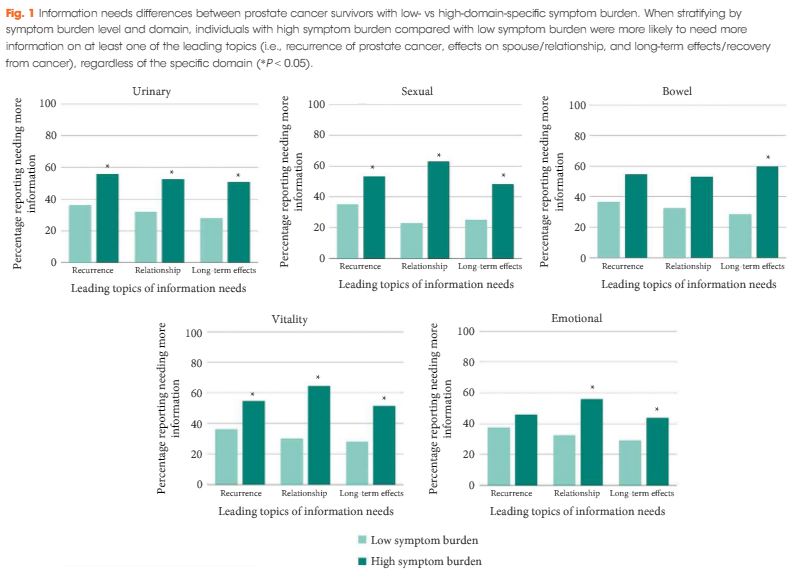Article of the Week: Symptom Burden and Information Needs in PCa Survivors
Every Week the Editor-in-Chief selects an Article of the Week from the current issue of BJUI. The abstract is reproduced below and you can click on the button to read the full article, which is freely available to all readers for at least 30 days from the time of this post.
In addition to the article itself, there is an accompanying editorial written by a prominent member of the urological community. This blog is intended to provoke comment and discussion and we invite you to use the comment tools at the bottom of each post to join the conversation.
If you only have time to read one article this week, it should be this one.
Symptom burden and information needs in prostate cancer survivors: a case for tailored long-term survivorship care
Objectives
To determine the relationship between long-term prostate cancer survivors’ symptom burden and information needs.
Patients and Methods
We used population-based data from the Michigan Prostate Cancer Survivor Study (2499 men). We examined unadjusted differences in long-term information needs according to symptom burden and performed multivariable logistic regression to examine symptom burden and information needs adjusting for patient characteristics.
Results
High symptom burden was reported across all domains (sexual 44.4%, urinary 14.4%, vitality 12.7%, bowel 8.4%, emotional 7.6%) with over half of respondents (56%) reporting they needed more information. Top information needs involved recurrence, relationships, and long-term effects. Prostate cancer survivors with high symptom burden more often searched for information regardless of domain (P < 0.05). High sexual burden was associated with greater need for information about relationships [odds ratio (OR) 2.05, 95% confidence interval (CI) 1.54–2.72] and long-term effects (OR 1.60, 95% CI 1.23–2.07). High bowel burden was associated with greater information need for long-term effects (OR 2.28, 95% CI 1.43–3.63).
Conclusions
Long-term prostate cancer survivors with high symptom burden need more supportive information. Tailoring information to these needs may be an efficient approach to support the growing population of long-term prostate cancer survivors.




In this brilliant article, the authors have divided the burdens described as “high” by patients following prostatectomy or combination therapy into six categories that for the purpose of my comment I will label as (a) reoccurrence (b) incontinence (c) impotence (d) bowel issues (e) vitality and (f) emotional issues.
The data the authors present does not allow the reader to know how many men had combinations of these burdens. So for the purpose of my comment, I am going to make what I hope is a reasonable assumption that burdens (a) – (d) were evenly distributed between the men observed and that burdens (e) – (f) were only experienced by men who had at least one of the burdens (a) – (d) mentioned by the authors.
What the article shows is that for 1000 men observed, 123 reported that they had experienced a reoccurrence of CaP. They had borne the burden of the treatment and it had failed.
Out of that 1000 men, this leaves 877 men for whom the treatment countered the disease. However, the article shows at what cost.
On the assumptions made above, 14.4% of those 877 men reported that they had a high “urinary burden” which, for shorthand, I will refer to as symptoms of incontinence. That is 126 men out of the 877 men.
Still, that leaves 751 men who did not report a reoccurrence or incontinence. However, on my assumptions, of those 751 men, 8.4% reported “high” bowel issues – a total of 63 men.
That leaves 688 men who reported neither reoccurrence, nor incontinence nor a high burden of bowel issues.
However, on my assumptions, of those 688 men, 44.4% reported a high sexual burden, i.e impotence. This amounts to 305 men.
So, of the 1000 men who had a prostatectomy or combination treatment, only 383 emerged without the burdens mentioned above that they described as high.
One needs to be a bit careful about the analysis I set out above, because the study does not appear to have asked the men how high their burdens were, if at all, before their treatment. And one also needs to bear in mind that CaP had it been allowed to progress would have had its own burdens. Moreover, one also needs to be careful, because over 6531 questionaires were sent out and 2499 or so were returned, and it may be that those who had the greatest burden were more likely to return their questionnaire.
Nevertheless, accepting all the limitations of the study, assuming an even burden distribution of burdens (a) – (d) between the men observed due to the way the data has been presented, the fact that 617 men either reported a reoccurrence or a high burden is, I believe, many would say not a very happy result for a sizeable majority of the men.
It would be extremely interesting if the authors could report their data in the same form recommended by the Harding Institute for Risk at the Max Plank Institute in Germany so that one could easily see how burdens (a) – (d) were distributed across the men. Plainly, some men will have had the misfortune that they have reported each one of burdens (a) – (d), a truly miserable result for them. Some will have other combinations of symptoms.
The authors have used their data to make recommendations as to information that should be supplied to the men. But I think that an even more valuable aspect of the exercise that they have done is that they have gathered, although not necessarily reported, data that gives a very valuable picture of how burdensome typical treatment is for CaP. It would therefore be extremely interesting to see that data in a form that would show the burden distribution.
There is no well-established form of “tripadvisor” site in which patients are encouraged to report on their experience of CaP treatment. In many ways that is a great pity because the Medicine and the Science should be driven by what – yes, I will use this word – the customer’s experience is. What I found valuable in the study that these excellent authors have done is that, however softly, one can discern the voice customer and, for me, it is a voice that says the burden of treatment has been high for many. In many ways, it is a sobering study in the extent of the misery that the men in it report.